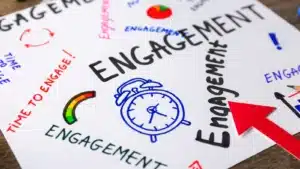
Poll Questions That Prompt Insightful Conversations and Decisions
In today’s fast-paced world, the ability to engage an audience effectively is more crucial than ever. Whether in corporate settings, educational environments, or public speaking events, the right questions can transform a passive audience into active participants. Poll questions not only gather opinions but also foster insightful conversations that lead to better decision-making. This article explores how to craft poll questions that stimulate dialogue and drive meaningful outcomes.
The Importance of Poll Questions
Poll questions serve as a bridge between presenters and their audiences, encouraging interaction and feedback. They can help presenters gauge understanding, spark discussions, and even uncover insights that may not surface through traditional Q&A sessions. By integrating these questions into their presentations, speakers can foster a more dynamic and responsive atmosphere, where the audience feels empowered to contribute actively to the conversation.
Moreover, in a landscape where virtual meetings are prevalent, the challenge of engaging participants becomes even more significant. Poll questions can break the ice, making it easier for attendees to voice their thoughts and concerns, thereby enhancing the overall experience. They can also serve as a tool for presenters to assess the mood of the room, allowing them to tailor their approach to better resonate with the audience. This adaptability can lead to a more impactful presentation, as it aligns the content with the audience’s interests and needs.
Enhancing Engagement Through Interaction
One of the key benefits of incorporating poll questions into presentations is the immediate feedback they provide. This feedback can guide the direction of the conversation, allowing presenters to adjust their content in real-time based on audience reactions. For instance, if a poll reveals that a significant portion of the audience is confused about a specific topic, the presenter can take a moment to clarify before moving on. This responsiveness not only aids comprehension but also demonstrates to the audience that their input is valued, fostering a sense of community and collaboration.
PresEngage utilizes AI-powered tools to facilitate real-time Q&A, ensuring that every audience question is addressed promptly. This hands-free approach allows presenters to focus on delivering their message while still engaging with their audience effectively. The use of such technology can streamline the interaction process, making it easier for presenters to manage multiple questions and comments without losing their train of thought. Furthermore, the data collected from these polls can be analyzed post-presentation, providing valuable insights into audience preferences and knowledge gaps that can inform future presentations.
Creating a Safe Space for Participation
Poll questions can also create a safe environment for audience members who may be hesitant to speak up. By allowing participants to respond anonymously, presenters can encourage more honest and open feedback. This is particularly beneficial in settings where power dynamics may inhibit participation, such as corporate meetings or educational lectures. The anonymity provided by polls can help level the playing field, giving everyone an equal opportunity to express their views without fear of judgment.
With tools that enable SMS participation, such as those offered by PresEngage, attendees can easily send their responses without the need for apps or logins. This frictionless experience not only increases engagement but also ensures that every voice is heard. By simplifying the process of participation, presenters can tap into a wider range of perspectives, enriching the discussion and creating a more inclusive environment. Additionally, the ability to quickly gather responses allows for a more agile presentation style, where presenters can pivot their focus based on real-time audience feedback, ultimately leading to a more engaging and productive session.
Crafting Effective Poll Questions
Not all poll questions are created equal. The effectiveness of a poll largely depends on how well the questions are crafted. Here are some tips for developing impactful poll questions that prompt insightful conversations.
Be Clear and Concise
Clarity is paramount when formulating poll questions. Ambiguous or overly complex questions can lead to confusion and disengagement. Instead, aim for straightforward language that conveys the question’s intent clearly. For instance, rather than asking, “What are your thoughts on our current strategy?” consider rephrasing it to “Do you believe our current strategy is effective? Yes or No?”
By simplifying the language, participants can quickly grasp the question, leading to more accurate responses and richer discussions. Furthermore, incorporating context can enhance clarity. Providing a brief background or rationale for the question can help participants understand its relevance, making them more likely to engage thoughtfully. For example, adding a sentence like “This question aims to assess our alignment with market trends” can provide the necessary context that encourages deeper reflection.
Encourage Open-Ended Responses
While multiple-choice questions are useful for quantifying opinions, open-ended questions can elicit deeper insights. For example, instead of asking, “Which feature do you prefer?” a more engaging question might be, “What features would you like to see in our next product?”
This approach invites participants to share their thoughts and ideas, fostering a collaborative atmosphere where everyone feels valued. Additionally, AI-powered platforms can analyze these responses, providing presenters with actionable insights that can inform future strategies. The richness of open-ended responses can also reveal trends and sentiments that might not be captured through standard metrics, allowing for a more nuanced understanding of participant perspectives. By categorizing these responses, organizations can identify common themes and prioritize areas for development, ultimately enhancing product offerings and customer satisfaction.
Utilize Follow-Up Questions
Follow-up questions can deepen the conversation and encourage further exploration of the topic. After receiving initial feedback, presenters can ask, “Why do you feel that way?” or “Can you elaborate on your experience?” This not only shows that the presenter values the audience’s input but also opens the door for more comprehensive discussions.
Incorporating smart prompting features, as seen in platforms like PresEngage, can help guide participants who may be hesitant to elaborate. This ensures that valuable insights are not lost and that the conversation continues to flow. Moreover, follow-up questions can also serve to clarify any misunderstandings that may arise from initial responses. By actively engaging with participants, presenters can create a dynamic dialogue that not only enriches the discussion but also fosters a sense of community and shared purpose. This level of engagement can lead to more robust feedback, ultimately driving better decision-making and innovation within the organization.
Types of Poll Questions to Consider
There are various types of poll questions that can be employed to stimulate conversation and decision-making. Each type serves a unique purpose and can be tailored to fit the context of the presentation.
Opinion-Based Questions
Opinion-based questions are designed to gauge the audience’s feelings or beliefs about a particular topic. These questions can help presenters understand the prevailing attitudes within the group. For example, asking, “How do you feel about our new marketing strategy?” can provide insights into the audience’s sentiments and allow for a more targeted discussion.
Such questions can also highlight areas of agreement or disagreement, paving the way for constructive dialogue that can lead to better decision-making. Furthermore, they can reveal underlying concerns or misconceptions that may not be immediately apparent, allowing presenters to address these issues head-on. By fostering an environment where participants feel comfortable sharing their opinions, presenters can create a more inclusive atmosphere that encourages diverse perspectives.
Knowledge Check Questions
Knowledge check questions are effective for assessing the audience’s understanding of the material presented. Questions like, “What is the primary goal of our new initiative?” can help presenters identify knowledge gaps and adjust their content accordingly.
These questions not only reinforce learning but also encourage participants to engage more actively with the material, fostering a culture of continuous improvement. Additionally, incorporating knowledge check questions can serve as a valuable feedback mechanism, allowing presenters to gauge the effectiveness of their teaching methods. By analyzing the responses, they can refine their approach and ensure that the content resonates with the audience, ultimately enhancing the overall learning experience.
Preference Questions
Preference questions can help presenters make decisions based on audience input. For instance, asking, “Which of these options do you prefer for our next team-building activity?” can provide valuable insights into what resonates with the audience.
By involving participants in the decision-making process, presenters can enhance buy-in and commitment to the outcomes, leading to more successful implementations. Moreover, preference questions can also serve as a springboard for deeper discussions about values and priorities within the group. When participants express their preferences, it opens the door for dialogue about why certain options are favored over others, allowing for a richer understanding of the group’s dynamics. This not only aids in making informed decisions but also strengthens team cohesion as members feel their voices are heard and valued in the process.
Leveraging Technology for Polling
Incorporating technology into polling can significantly enhance the effectiveness of audience engagement. Modern platforms offer a range of features that streamline the polling process and provide valuable analytics.
Real-Time Analytics
Utilizing PresEngage allows presenters to access real-time analytics on audience engagement. Metrics such as response rates, question volume, and participant demographics can provide insights into how well the presentation is resonating with the audience.
These analytics can inform future presentations, enabling presenters to tailor their content to better meet the needs and preferences of their audience. By understanding what works and what doesn’t, presenters can continuously improve their approach.
Seamless Integration
Integrating polling tools with existing systems can streamline the presentation process. Platforms that offer CRM integration, for example, can automatically capture leads and follow-up information, turning engagement into actionable business opportunities.
By simplifying the workflow, presenters can focus on delivering impactful content while ensuring that no valuable insights are lost in the process.
Engagement Through SMS
One of the standout features of modern polling platforms is the ability to engage audiences through SMS. This approach eliminates the need for participants to download apps or create accounts, making it easier for everyone to participate.
With SMS polling, attendees can respond quickly and anonymously, fostering a more inclusive environment. This method is particularly effective in virtual settings, where audience engagement can be challenging to achieve.
Best Practices for Implementing Poll Questions
To maximize the effectiveness of poll questions, presenters should adhere to several best practices that enhance engagement and ensure meaningful conversations.
Timing is Key
Strategically timing poll questions throughout the presentation can significantly impact engagement. Introducing a poll after presenting key information allows participants to reflect on what they’ve just learned and share their thoughts.
Additionally, using polls to break up long segments of content can help maintain audience interest and prevent fatigue. This keeps the energy levels high and encourages active participation throughout the presentation.
Encourage Participation
Encouraging participation is essential for fostering a collaborative environment. Presenters can invite attendees to share their thoughts openly and reassure them that all opinions are valued. This can be reinforced by acknowledging responses and thanking participants for their contributions.
Moreover, leveraging AI-powered prompting tools can help engage quieter participants, ensuring that everyone has an opportunity to contribute to the discussion.

Follow Up After the Presentation
Following up with participants after the presentation can reinforce the importance of their input and keep the conversation going. Presenters can share the results of the polls, highlight key insights, and outline next steps based on audience feedback.
This not only shows that the presenter values the audience’s contributions but also fosters a sense of community and collaboration that can lead to more productive outcomes in the future.
Unlock the Power of Audience Engagement with PresEngage
Ready to take your presentations to the next level? PresEngage offers you the cutting-edge advantage of AI-powered SMS Q&A, enabling real-time interaction that captivates your audience. Say goodbye to the hurdles of app downloads and hello to seamless, inclusive conversations. Whether you’re a presenter, educator, or business professional, PresEngage is your partner in transforming every presentation into an opportunity for growth and connection. Start for FREE today and experience the future of audience engagement.
Present Smarter. Engage Answer Convert Close Remarkably.
Dazzle your audience with Real-Time Q&A powered by your AI Co-Presenter.(Patent Pending)
PresEngage™ makes you look brilliant by connecting with everyone, instantly.
No Credit Card Required. 100% Risk Free.
Frictionless Audience Experience GUARANTEED.






